
Rapid feedback regulation of synaptic efficacy during high-frequency activity at the Drosophila larval neuromuscular junction
Abstract
High-frequency firing of neurons depresses transmitter release at many synapses. At the glutamatergic synapse of the Drosophila larval neuromuscular junction, we find that presynaptic depression is modulated by postsynaptic ionotropic glutamate receptor (iGluR) activity. Although basal release at low frequency was insensitive to postsynaptic iGluR activity, recovery from depression elicited by high-frequency presynaptic trains decreased with partial block of native iGluRs. Moreover, recovery from depression increased with optical activation of the light-gated mammalian iGluR6 (LiGluR) expressed postsynaptically. The enhancement of recovery from depression occurred within 2 min of optical activation of LiGluR and persisted for minutes after optical deactivation. This effect depended on cAMP-dependent presynaptic recruitment of vesicles from the reserve pool. Our findings reveal a unique dimension to postsynaptic iGluR activity: fast retrograde signaling that preserves transmission efficacy during high-frequency presynaptic firing.